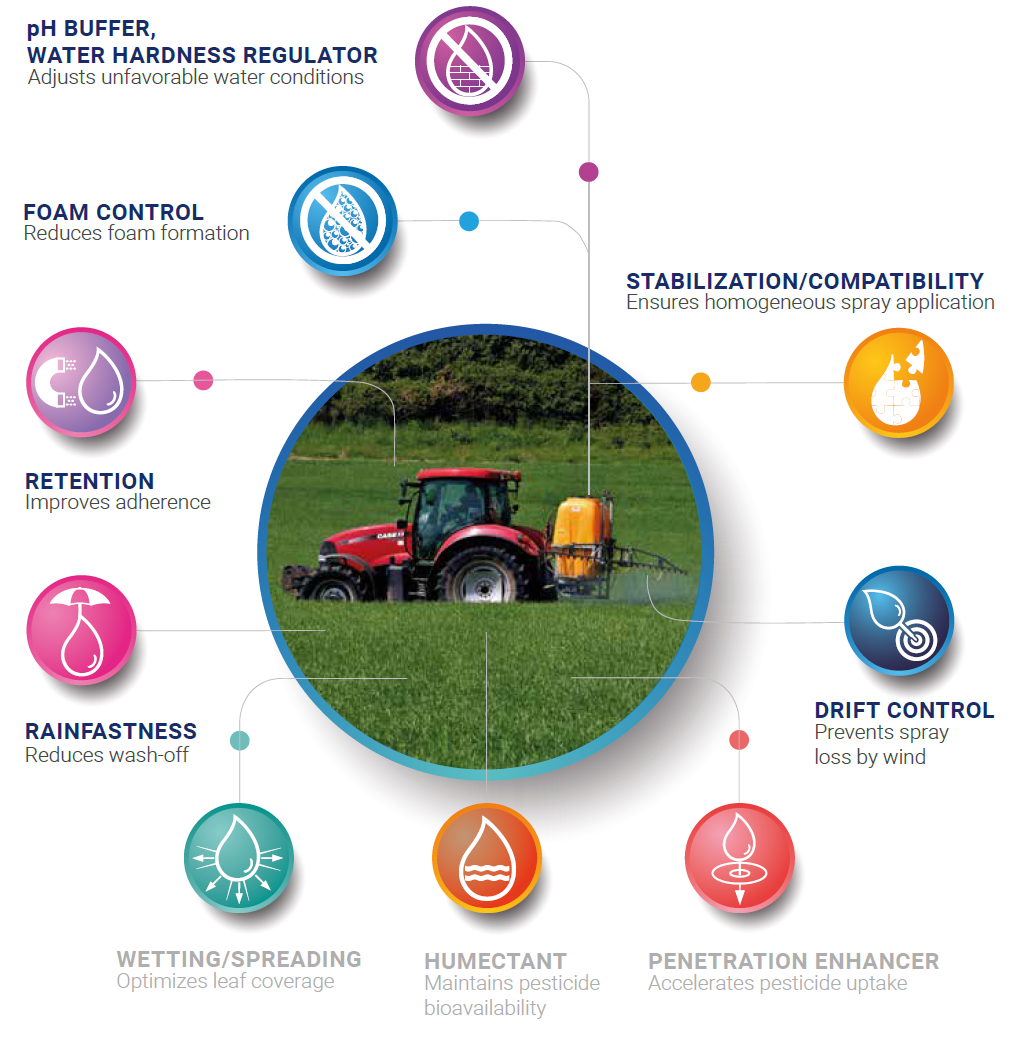Utility adjuvants
Utility adjuvants
Utility adjuvants modify the physical properties of spray mixtures which may enhance the stabilization, reduce wind drift, improve retention, or ensures rainfastness. These additives play a crucial role in optimizing the overall performance of crop protection product applications, contributing to increased efficacy, and reduced environmental impact.
Ways in which tank mix adjuvants improve the spray application:


pH buffer, water hardness regulator
Water hardness and pH-value have a strong impact on the stability of the spray mixture. Farmers observe that the spray mixture can change in its effectiveness when different water sources are used. To avoid the negative effects of an adverse pH-value and high water hardness, specialized tank mix adjuvants containing buffer systems are used to adjust the pH-value and reduce water hardness.

Stabilization/compatibility
Often, different crop protection products, formulation types (e.g. EC, SC or OD), or adjuvant oils are combined in a single spray mixture. Many of these combinations show a poor compatibility with their mix partners, resulting in rapid phase separation or sedimentation. When the spray mixture is not homogeneous, it leads to an uneven distribution on the crops, causing some areas to receive either excessively high or low concentrations of the crop protection product. This can result in ineffective disease control, phytotoxic effects, or even the development of resistance in the target organism. Specialized tank mix adjuvants, containing specific surfactants, are designed to prevent or slow down the effects of phase separation. Consequently, a spray mixture that would usually separate within minutes forms a long-term stable and uniform mixture when the right adjuvant is used.

Foam control
The dilution of active ingredient concentrates in water sometimes leads to the formation of foam which may become an issue. While foam does not impact the quality of the spray mixture, it does cause a complication by foaming out of the spray tank and possibly endangering the operator. In this case, defoamers can be added to the tank mixture to reduce or prevent any foam formation.

Drift control
When the operator is spraying the spray mixture onto the crops in windy weather conditions, a significant amount of the spray can be carried away, missing its targeted leaves. This not only reduces the efficacy of disease control but also causes a risk of environmental contamination. The extent of spray drift is strongly dependent on droplet size. Even at low wind speeds, small and light droplets are easily carried away, unlike heavier and larger droplets. When the spray nozzle is set to an increased droplet size, it can reduce drift, but it may also generate too large droplets that can easily run off the leaf. A specialized tank mix adjuvant effectively minimizes drift by modifying the physical properties of the spray liquid, creating a narrow droplet size distribution. Combined with a well-adjusted spray nozzle, this ensures that most droplets are of optimal size, preventing run off and minimizing the risk of being carried away by the wind.

Retention
After the sprayed droplets reach the leaf surface, it is crucial that they adhere to it. Crop protection products running off the leaf and onto the ground result in less efficient disease control and environmental issues. Therefore, special adjuvants are used to modify the droplets, making them inelastic and sticky. This ensures that the droplets spread on the leaf without bouncing or flowing off.

Rainfastness
In humid and rainy areas, a challenge is the loss of crop protection products washed-off by rain. To reduce this loss, tank mixes with hydrophobic or film-forming adjuvants are used. These adjuvants spread on the leaf and can repel the rain. They adhere to the leaf surface, either physically or chemically, protecting the active ingredient from rain. Thus, these adjuvants extend the time for the crop protection products to penetrate into the leaf.
